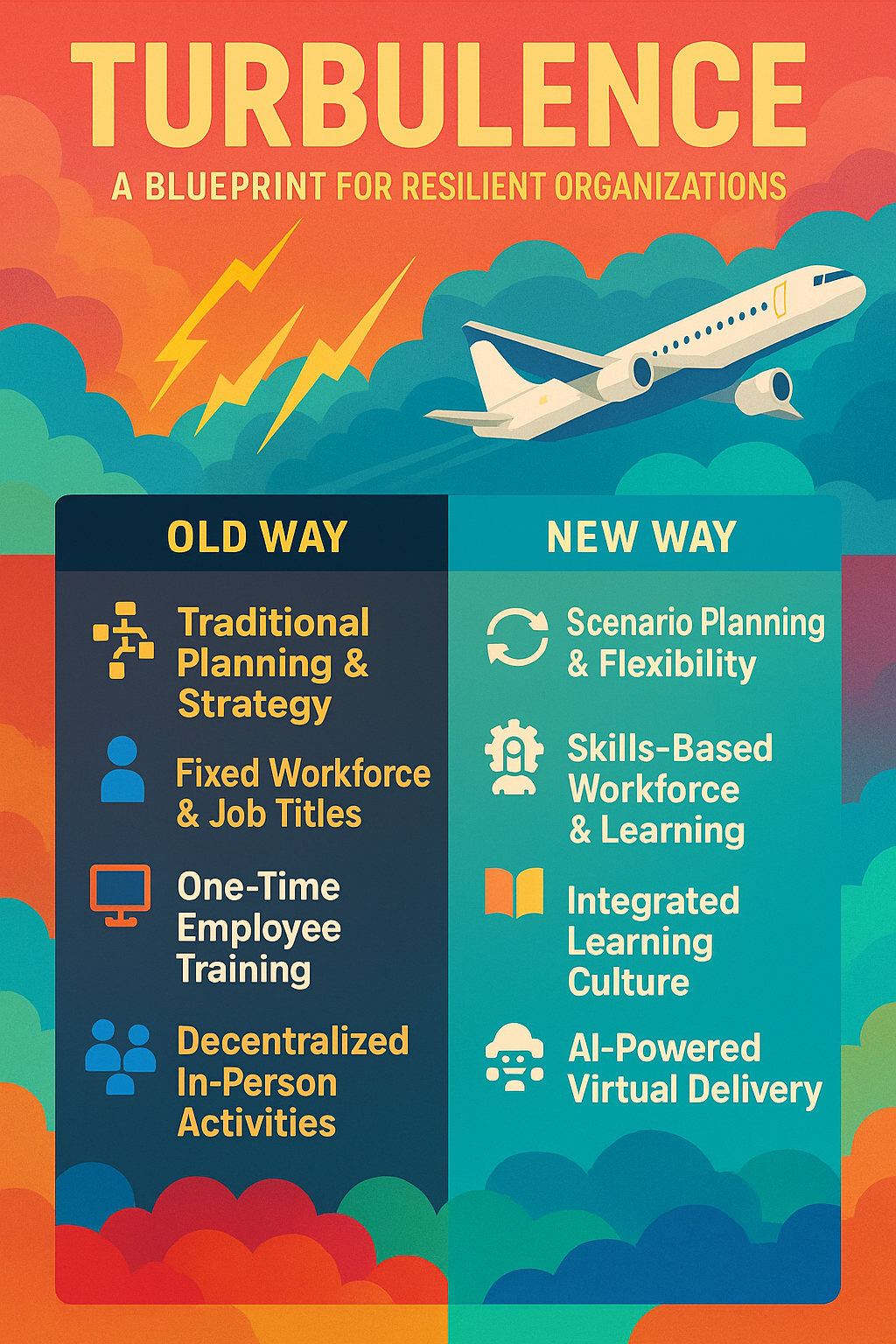1. Living with the Seatbelt Sign On: The New Reality of Business
The world has always been unstable. Yet something feels fundamentally different now.
Where turbulence was once episodic—wars, financial crises, political upheavals—it is now perpetual. Supply chain shocks, AI disruption, regulatory tsunamis, demographic shifts: the forces battering organizations are relentless and often unpredictable.
In this environment, businesses can no longer plan to avoid turbulence.
They must design to operate within it.
The seatbelt sign is permanently on. Leaders must stop waiting for the air to clear—and instead, learn to fly through storms with skill, adaptability, and resilience.
2. From Forecasting to Flexibility: Why Traditional Planning Is Broken
Organizations built on static models—fixed hierarchies, rigid job descriptions, linear strategies—are increasingly unfit for purpose.
In this age of uncertainty:
-
Scenario planning must replace static roadmaps.
-
Agile workforce models must replace bureaucratic hiring.
-
Modular learning and reskilling must replace one-time education.
You can no longer “future-proof” against a single threat. You must future-flex against whatever comes.
This is why forward-looking organizations are pivoting to Virtual Delivery Centers (VDCs): fluid, skill-first execution engines that can assemble, reassemble, and surge capabilities on-demand.
VDCs aren’t just cost-efficient. They’re turbulence-ready.
3. Five Imperatives for Organizations to Stay Airborne
Across discussions with CHROs and organizational leaders, five critical shifts have emerged for businesses determined to fly—and not crash—through chaos:
a. Shift to a Skills-Based Workforce
Degrees are outdated. Titles are too slow. Skills are the new currency.
In Europe alone, 80% of employers report struggling to find the right capabilities—even with open positions.
Organizations must hire for missions, not for roles—identifying real-world skills over credentials, learning agility over linear experience.
VDCs operationalize this by assembling teams around problem statements—not job titles. They access talent based on demonstrated capability, bypassing outdated filters.
b. Accelerate Upskilling and Reskilling
The future isn’t about who you hired—it’s about who can evolve.
By 2030, 60% of the global workforce will need new skills. Yet half of today's workers feel their employers are not investing enough in them.
Organizations must treat learning as oxygen—constant, personalized, embedded into work itself.
VDCs solve this by creating learning loops inside project execution: employees learn while doing, upgrading skills without interrupting productivity.
c. Anticipate and Navigate Risks Proactively
Regulatory shifts. Talent nationalism. Geopolitical fragmentation. ESG backlash.
HR can no longer simply react to change—it must lead in reading the signals and shaping strategy.
Smart organizations are building geopolitical nerve centers inside HR, legal, and business planning units—embedding resilience into the corporate DNA.
The VDC model, by its very design, distributes execution across geographies—giving organizations geopolitical agility instead of overconcentration risk.
d. Drive AI Adoption with Strategic HR Leadership
AI is no longer a side conversation. It is the conversation.
Yet too many organizations view AI as a tech issue, not a human capital one.
True leaders are embedding AI into:
-
Talent sourcing (AI-matched skills to roles)
-
Workforce planning (predictive retention modeling)
-
Learning journeys (AI-personalized upskilling)
-
Cultural change management (AI ethics and adoption frameworks)
VDCs are already AI-first ecosystems—building intelligence directly into how work is assigned, executed, and improved.
e. Reinvent the Employee Experience
Employee expectations are diverging sharply:
-
Gen Z demands flexibility, meaning, and autonomy.
-
Millennials seek leadership pathways and skill growth.
-
Gen X and Boomers want relevance, respect, and adaptive rewards.
One-size-fits-all Employee Value Propositions (EVPs) will fail.
Organizations must modularize their EVP—offering personalized pathways, rewards, and cultural belonging tailored to individuals.
In the VDC world, talent is free to pick projects that align with their skills and ambitions—creating natural personalization without bureaucratic redesign.
4. Virtual Delivery Centers: The Perfect Model for an Uncertain World
The VDC model is not an experiment—it is the blueprint for resilience.
-
Elasticity: Scale up or down as turbulence demands.
-
Skill Matching: Solve complex problems faster with curated expertise.
-
Speed: Reduce execution cycle times from months to weeks.
-
Global Resilience: Tap worldwide talent pools, mitigating local shocks.
-
Embedded Learning: Deliver projects that upgrade talent as a side effect.
The VDC is the anti-fragile workforce model: it gets stronger as volatility increases.
5. Leading with Courage When the Sky Is Dark
Turbulence doesn’t just require new systems. It requires new leadership muscles.
The leaders who will succeed are those who:
-
Embrace uncertainty, not resist it.
-
Prioritize adaptability over perfection.
-
Communicate with radical transparency.
-
Foster cultures where agility is a core value, not an emergency response.
When storms hit, leadership is not about predicting the exact path. It’s about building teams that can navigate any path.
In the age of VDCs, leadership is decentralized, empowered, and faster—because control is an illusion in an unstable sky.
6. Conclusion: Build for Flight, Not for Calm
We are entering an era where organizations must behave more like pilots than architects.
Architects build for predictability. Pilots fly through dynamic conditions—adjusting, responding, improvising while staying on mission.
The next decade will belong to organizations that:
-
Design for instability
-
Embed learning in work
-
Access talent through skills, not resumes
-
Harness AI responsibly and urgently
-
Create cultures of resilient curiosity
The turbulence is not going away. But those who lean in, design for it, and build Virtual Delivery Centers as their new engines will not only survive.
They will soar.

